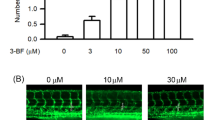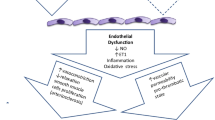Abstract
To clarify the molecular mechanisms through which arsenic causes injuries to blood vessels, we analyzed the effects of sodium arsenite (NaAsO2) on the apoptosis of human umbilical vein endothelial cells (HUVECs), mitochondrial membrane potential (ΔΨm), intracellular reactive oxygen species (ROS), and the expression of the related genes. HUVECs apoptosis increased and ΔΨm decreased in a dose-dependent manner following arsenic treatment. Intracellular ROS showed 2 phase alterations: a slight decrease with low levels of arsenic (5 and 10 μM) treatment; but a sharp increase at higher concentrations (≧20 μM). The arsenic-induced cell apoptosis and intracellular ROS were blocked by the addition of the antioxidant N-acetyl-l-cysteine (NAC). The mRNAs of superoxide dismutase 2 (SOD2) and NAD(P)H:quinone oxidoreductase 1 (NQO1) increased strikingly when cells were treated with a low concentration of NaAsO2 (5 μM) and the level of induction was decreased with higher concentrations of arsenic treatment. Based on the results, we suggest that the decrease of ΔΨm caused by arsenic and the resulting cell apoptosis may contribute to the injuries of blood vessel in arsenism. The decrease in intracellular ROS and the increase in SOD2 and NQO1 expressions observed when HUVECs were treated with low concentration of NaAsO2, suggest the role of the two enzymes in protecting HUVECs from injuries of arsenic exposure.



Similar content being viewed by others
References
Rahman, M. M., Naidu, R., & Bhattacharya, P. (2009). Arsenic contamination in groundwater in the Southeast Asia region. Environmental Geochemistry and Health, 31(Suppl 1), 9–21.
Yu, G., Sun, D., & Zheng, Y. (2007). Health effects of exposure to natural arsenic in groundwater and coal in China: An overview of occurrence. Environmental Health Perspectives, 115, 636–642.
Sun, G. (2004). Arsenic contamination and arsenicosis in China. Toxicology and Applied Pharmacology, 198, 268–271.
Mukherjee, A., Sengupta, M. K., Hossain, M. A., Ahamed, S., Das, B., Nayak, B., et al. (2006). Arsenic contamination in groundwater: A global perspective with emphasis on the Asian scenario. Journal of Health, Population, and Nutrition, 24, 142–163.
Wu, M. M., Kuo, T. L., Hwang, Y. H., & Chen, C. J. (1989). Dose-response relation between arsenic concentration in well water and mortality from cancers and vascular diseases. American Journal of Epidemiology, 130, 1123–1132.
Chang, C. C., Ho, S. C., Tsai, S. S., & Yang, C. Y. (2004). Ischemic heart disease mortality reduction in an arseniasis-endemic area in southwestern Taiwan after a switch in the tap-water supply system. Journal of Toxicology and Environmental Health: Part A, 67, 1353–1361.
Navas-Acien, A., Silbergeld, E. K., Pastor-Barriuso, R., & Guallar, E. (2008). Arsenic exposure and prevalence of type 2 diabetes in US adults. Jama, 300, 814–822.
Coronado-Gonzalez, J. A., Del Razo, L. M., Garcia-Vargas, G., Sanmiguel-Salazar, F., & Escobedo-de la Pena, J. (2007). Inorganic arsenic exposure and type 2 diabetes mellitus in Mexico. Environmental Research, 104, 383–389.
Chiu, H. F., Chang, C. C., Tsai, S. S., & Yang, C. Y. (2006). Does arsenic exposure increase the risk for diabetes mellitus? Journal of Occupational and Environmental Medicine, 48, 63–67.
Tseng, C. H., Chong, C. K., Chen, C. J., & Tai, T. Y. (1997). Lipid profile and peripheral vascular disease in arseniasis-hyperendemic villages in Taiwan. Angiology, 48, 321–335.
Tseng, C. H., Huang, Y. K., Huang, Y. L., Chung, C. J., Yang, M. H., Chen, C. J., et al. (2005). Arsenic exposure, urinary arsenic speciation, and peripheral vascular disease in blackfoot disease-hyperendemic villages in Taiwan. Toxicology and Applied Pharmacology, 206, 299–308.
Tseng, C. H., Chong, C. K., Chen, C. J., Lin, B. J., & Tai, T. Y. (1995). Abnormal peripheral microcirculation in seemingly normal subjects living in blackfoot-disease-hyperendemic villages in Taiwan. International Journal of Microcirculation, Clinical and Experimental, 15, 21–27.
Tseng, C. H., Chong, C. K., Chen, C. J., & Tai, T. Y. (1996). Dose-response relationship between peripheral vascular disease and ingested inorganic arsenic among residents in blackfoot disease endemic villages in Taiwan. Atherosclerosis, 120, 125–133.
Tseng, C. H., Chong, C. K., Tseng, C. P., & Centeno, J. A. (2007). Blackfoot disease in Taiwan: Its link with inorganic arsenic exposure from drinking water. Ambio, 36, 82–84.
Balakumar, P., & Kaur, J. (2009). Arsenic exposure and cardiovascular disorders: An overview. Cardiovascular Toxicology, 9, 169–176.
Tseng, C. H. (2008). Cardiovascular disease in arsenic-exposed subjects living in the arseniasis-hyperendemic areas in Taiwan. Atherosclerosis, 199, 12–18.
Mannarino, E., & Pirro, M. (2008). Endothelial injury and repair: A novel theory for atherosclerosis. Angiology, 59, 69S–72S.
Kao, Y. H., Yu, C. L., Chang, L. W., & Yu, H. S. (2003). Low concentrations of arsenic induce vascular endothelial growth factor and nitric oxide release and stimulate angiogenesis in vitro. Chemical Research in Toxicology, 16, 460–468.
Woo, S. H., Park, M. J., An, S., Lee, H. C., Jin, H. O., Lee, S. J., et al. (2005). Diarsenic and tetraarsenic oxide inhibit cell cycle progression and bFGF- and VEGF-induced proliferation of human endothelial cells. Journal of Cellular Biochemistry, 95, 120–130.
Ramanathan, K., Anusuyadevi, M., Shila, S., & Panneerselvam, C. (2005). Ascorbic acid and alpha-tocopherol as potent modulators of apoptosis on arsenic induced toxicity in rats. Toxicology Letters, 156, 297–306.
Engel, R. H., & Evens, A. M. (2006). Oxidative stress and apoptosis: A new treatment paradigm in cancer. Frontiers in Bioscience, 11, 300–312.
Nohl, H., Gille, L., & Staniek, K. (2005). Intracellular generation of reactive oxygen species by mitochondria. Biochemical Pharmacology, 69, 719–723.
Liu, S. X., Athar, M., Lippai, I., Waldren, C., & Hei, T. K. (2001). Induction of oxyradicals by arsenic: Implication for mechanism of genotoxicity. Proceedings of the National Academy of Sciences of the United States of America, 98, 1643–1648.
Perez, M. J., & Cederbaum, A. I. (2003). Adenovirus-mediated expression of Cu/Zn- or Mn-superoxide dismutase protects against CYP2E1-dependent toxicity. Hepatology, 38, 1146–1158.
Epperly, M. W., Bernarding, M., Gretton, J., Jefferson, M., Nie, S., & Greenberger, J. S. (2003). Overexpression of the transgene for manganese superoxide dismutase (MnSOD) in 32D cl 3 cells prevents apoptosis induction by TNF-alpha, IL-3 withdrawal, and ionizing radiation. Experimental Hematology, 31, 465–474.
Faraci, F. M., & Didion, S. P. (2004). Vascular protection: Superoxide dismutase isoforms in the vessel wall. Arteriosclerosis, Thrombosis, and Vascular Biology, 24, 1367–1373.
Gaikwad, A., Long, D. J., 2nd, Stringer, J. L., & Jaiswal, A. K. (2001). In vivo role of NAD(P)H:Quinone oxidoreductase 1 (NQO1) in the regulation of intracellular redox state and accumulation of abdominal adipose tissue. J Biol Chem, 276, 22559–22564.
Joseph, P., Xie, T., Xu, Y., & Jaiswal, A. K. (1994). NAD(P)H:Quinone oxidoreductase1 (DT-diaphorase): Expression, regulation, and role in cancer. Oncology Research, 6, 525–532.
Ross, D., Kepa, J. K., Winski, S. L., Beall, H. D., Anwar, A., & Siegel, D. (2000). NAD(P)H:Quinone oxidoreductase 1 (NQO1): Chemoprotection, bioactivation, gene regulation and genetic polymorphisms. Chemico-Biological Interactions, 129, 77–97.
Reddy, V. N., Kasahara, E., Hiraoka, M., Lin, L. R., & Ho, Y. S. (2004). Effects of variation in superoxide dismutases (SOD) on oxidative stress and apoptosis in lens epithelium. Experimental Eye Research, 79, 859–868.
Wang, Y., Xu, Y., Wang, H., Xue, P., Li, X., Li, B., et al. (2009). Arsenic induces mitochondria-dependent apoptosis by reactive oxygen species generation rather than glutathione depletion in Chang human hepatocytes. Archives of Toxicology, 83, 899–908.
Acknowledgments
This study was supported by the National Natural Science Foundation of China (Grants: NSFC No. 30872193). We would like to express great appreciation to Drs Xuejin Su and Hang Gao for their excellent technical assistance and to Professor F. William Orr from the University of Manitoba in Canada for his great help in revising the manuscript.
Author information
Authors and Affiliations
Corresponding authors
Rights and permissions
About this article
Cite this article
Shi, Y., Wei, Y., Qu, S. et al. Arsenic Induces Apoptosis of Human Umbilical Vein Endothelial Cells Through Mitochondrial Pathways. Cardiovasc Toxicol 10, 153–160 (2010). https://doi.org/10.1007/s12012-010-9073-z
Published:
Issue Date:
DOI: https://doi.org/10.1007/s12012-010-9073-z




